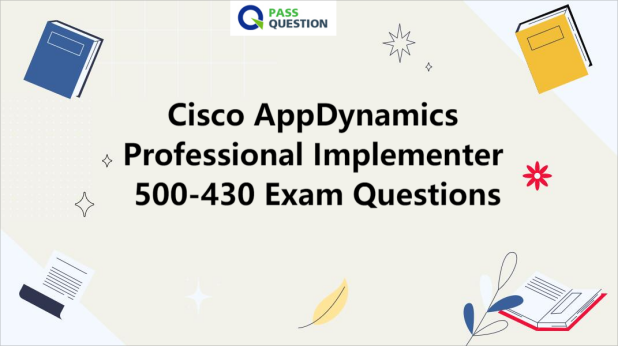Cisco AppDynamics Professional Implementer 500-430 Exam Questions
Are you fully prepared and confident to take on the challenge of the 500-430 Cisco AppDynamics Professional Implementer exam? PassQuestion provides a comprehensive collection of the latest Cisco AppDynamics Professional Implementer 500-430 Exam Questions that are designed to equip you with the knowledge and skills necessary to excel in your exam. By studying these Cisco AppDynamics Professional Implementer 500-430 Exam Questions, you can enhance your understanding of the subject matter and significantly increase your chances of passing the exam on your first try.

Cisco AppDynamics Professional Implementer
The Cisco AppDynamics Professional Implementer exam (CAPI 500-430) is a 90-minute test that validates the candidate's ability to deploy AppDynamics controllers, agents, analytics servers, and EUM servers. This certification confirms that candidates can apply their knowledge to both on-premises and cloud environments, using previous platform versions or the latest SaaS release. The Cisco AppDynamics Professional Implementer certification demonstrates proficiency in utilizing AppDynamics technologies and APIs to customize and enhance the platform.
Becoming a Cisco AppDynamics Professional Implementer may be suitable if you have 1-2 years of experience utilizing AppDynamics technologies to monitor system, application, and business process performance. You should possess the necessary knowledge and skills to deploy AppDynamics Controllers, Agents, and Servers, as well as utilize APIs to extend and customize the platform. This certification is valuable for architects, consultants, engineers, and administrators who work with AppDynamics technologies.
500-430 CAPI Exam Objectives
25% 1.0 Pre-Deployment Planning
1.1 Determine events cluster configuration and timing
1.2 Determine hardware needs
1.3 Determine controller deployment mode
1.4 Determine EUM server deployment mode
1.5 Determine controller system requirements
1.6 Determine when to use custom correlation
25% 2.0 Platform Installation and Administration
2.1 Install the controller (manually and on Linux)
2.2 Configure controller self-monitoring
2.3 Configure controller SSL
2.4 Configure high availability
2.5 Install events service cluster
2.6 Upgrade the controller
2.7 Upgrade the EUM server
2.8 Upgrade events service clusters
25% 3.0 Agent Configuration and Installation
3.1 Install the Java Agent
3.2 Install the .NET Agent
3.3 Install a standalone machine agent
3.4 Install a database agent
3.5 Install browser EUM
3.6 Use the mobile agent SDK
3.7 Install On-Premises EUEM Processor
3.8 Install the EUEM Agent
3.9 Upgrade the Java Agent
3.10 Upgrade the .NET Agent
3.11 Upgrade the Database Agent
5% 4.0 Post-Deployment Verification
4.1 Manage users in the Controller - RBAC
4.2 Perform platform health checks
4.3 Use the controller admin screen
20% 5.0 APIs
5.1 Create alerting extensions
5.2 Create custom events
5.3 Install alerting extensions
5.4 Retrieve health rule violations
5.5 Retrieve lists (Apps, Tiers, Nodes, and BTs)
5.6 Retrieve metric data
View Online Cisco AppDynamics Professional Implementer 500-430 CAPI Free Questions
1. Which implementation mode should be used when deploying an EUM Server with reverse proxy from a security and performance standpoint in a production environment?
A.Install the EUM Server on the same host as the Controller, behind the reverse proxy.
B.Install the EUM Server on a separate host from the Controller, in front of the reverse proxy.
C.Install the EUM Server on the same host as the Controller, in front of the reverse proxy.
D.Install the EUM Server on a separate host from the Controller, behind the reverse proxy.
Answer: D
2. Which two choices are available when specifying an application in a URL string for the Health Rule REST API? (Choose two.)
A.Application Alias
B.Application ID
C.Application GUID
D.Application Name
E.Application REGEX
Answer: B, D
3. Which two statements are true when updating the Database Agent? (Choose two.)
A.The Database Agent must be stopped and restarted during the upgrade.
B.If the agent is moved to a new location during the upgrade, the AppDynamics Controller must be reconfigured to reference the new location of the agent.
C.All data collectors created from the previous agent must be migrated to the new agent.
D.Controller-info.xml is the only file that needs to be migrated from the previous agent to the new agent.
E.After the Database Agent is upgraded, the AppDynamics Controller must be restarted.
Answer: A, D
4. The AppDynamics Controller is instrumented by an internal, out-of-the-box, AppDynamics Java agent. Which account and user name are used to connectto the Controller to view theinformation provided by the internal AppDynamics agent?
A.The account is ‘root’ and the user is ‘admin’.
B.The account is ‘customer!’ and the user is ‘root’.
C.The account is 'system' and the user is "root.
D.The account is internal’ and the user is ‘admin’.
Answer: C
5. Which three AppDynamics Controller properties govern how long metric data is retained in the database? (Choose three.)
A.metrics.ten.min.retention.period
B.metrics.ten.sec.retention.period
C.metrics.retention.period
D.metrics.min.retention. period
E.metrics. day retention period
F.metrics week retention period
Answer: A, C, D
6. Which two user accounts are created by the AppDynamies Controller during installation? (Choose two.)
A.Elastic search root user
B.GlassFish asadmin user
C.Customer-specified Controller administrator account
D.OS user that will run the controller
E.REST API user
F.MySQL appd admin user
Answer: B, C
7. What are two settings that an administrator can configure from the AppDynamics Controller Admin Console? (Choose two.)
A.Metrics baseline calculation
B.Controller log file rotation
C.Controller heap size
D.License allocation
E.Retention periods
Answer: D, E
8. What are three valid reasons to use the AppDynamics REST API to retrieve metrics? (Choose three.)
A.to archive 1-minute granularity data
B.to create a custom report to be run monthly to show average node availability
C.to calculate a new metric based on two existing metrics
D.to evaluate health rules
E.to retrieve health rule violations
F.to create an alert using a baseline to send to an internal ticketing system
Answer: A, C, E
- TOP 50 Exam Questions
-
Exam
All copyrights reserved 2025 PassQuestion NETWORK CO.,LIMITED. All Rights Reserved.

